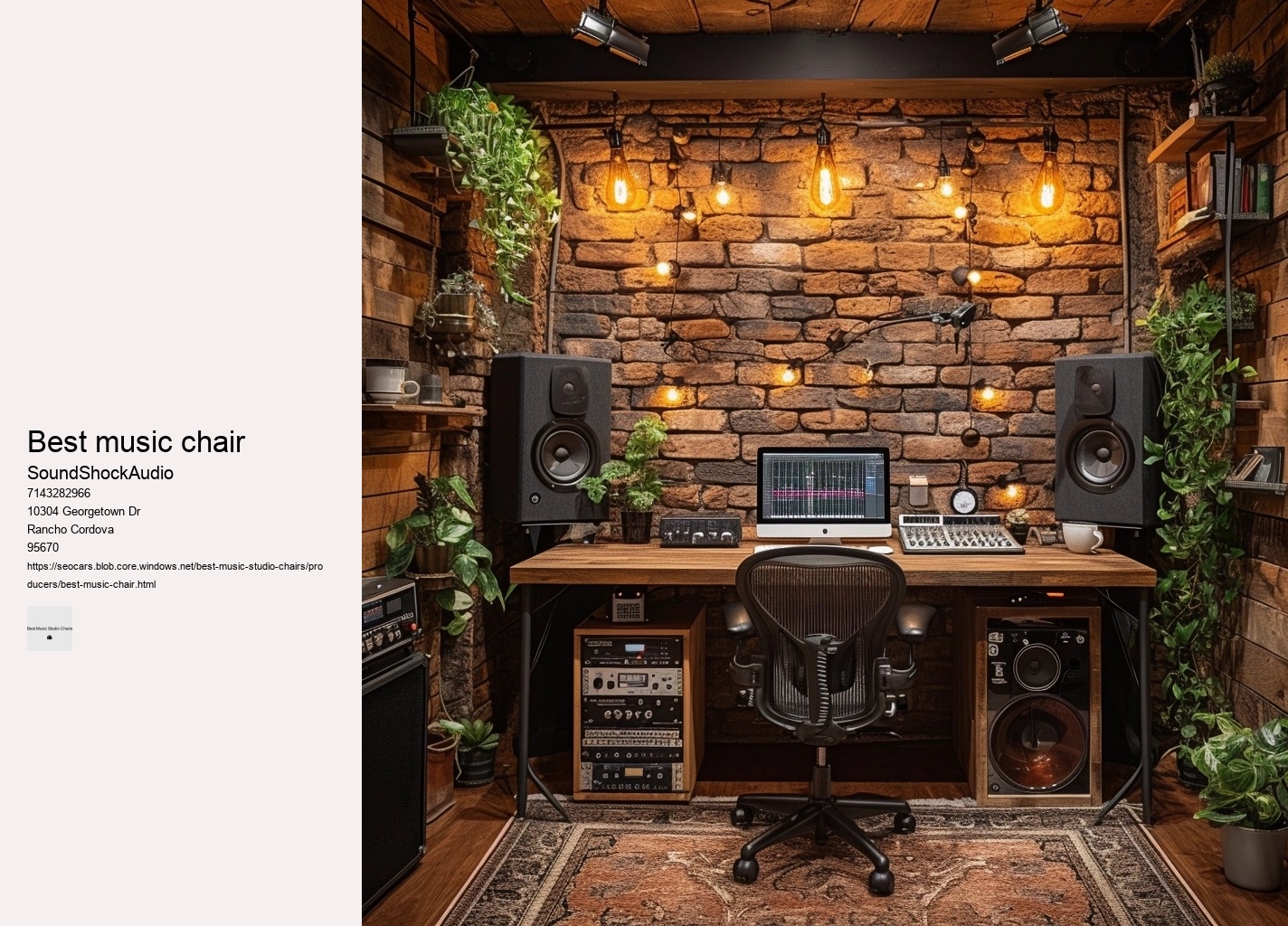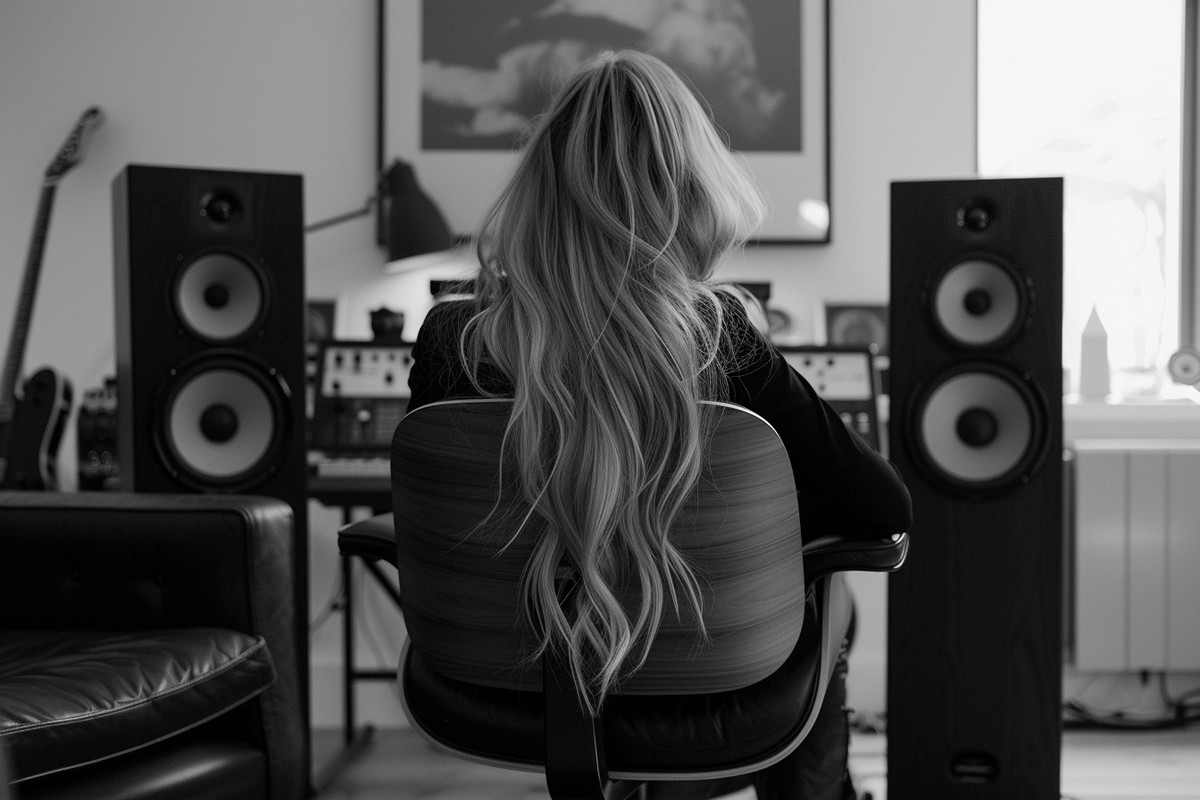

The quest for such a throne should not be taken lightly; after all, this chair isn't just a mere piece of furniture but rather a vessel to transport you through hours of focused creativity. Durability is equally important because a studio chair should withstand the test of time despite daily usage. Our bodies are designed for motion; however, during lengthy mixing sessions, we often remain static in a single position.
This exploration reveals the best studio chairs, ensuring your experience is unmatched in support and ease throughout editing or any task requiring prolonged sitting. Renowned for its ergonomic design, this chair boasts an innovative suspension system that distributes weight evenly, reducing pressure points.
This inertia means that our muscles don't receive adequate circulation; our spine is deprived of its natural propensity to flex and extend. As such, they invest in high-quality chairs engineered specifically to address the demands of their profession. standing desk
Adjustability is another keystone in finding your ideal creative companion. Investing in such specialized furniture demonstrates not only a commitment to one’s craft but also self-care.
Durability is another key consideration. Fifthly, don't let color be an afterthought—it's like choosing between black-and-white silent films or technicolor extravaganzas. Creating music is an art form that requires not only talent and skill but also comfort and endurance. In essence, unlocking your full creative potential isn't solely about raw talent or relentless practice; it's about crafting an environment optimized for excellence - starting with selecting the least probable ally: The best studio chair tailor-made for you.
Firstly, let's dissect 'ergonomic.' An ergonomic chair is designed with human anatomy and physiology in mind. This evolution symbolizes a broader shift towards recognizing the importance of human-centric design—not merely as an afterthought but as a fundamental consideration shaping how tools enhance our abilities rather than impose limitations upon them. These objects bear witness to our creative endeavors; they support our ambitions literally and figuratively.
Whether for painter's caverns, minstrel nests or weaver’s lairs, every stool must juggle twin enchantments." Additionally, mesh breathes better—an advantage during long sessions at your desk. Seat depth adjustment is another key element often overlooked but equally vital for tailored thigh support without cutting off circulation behind the knees – especially important for taller or shorter individuals who may need more or less space than what standard non-adjustable chairs offer.
Furthermore, features like seat depth adjustment cater to different leg lengths ensuring proper circulation; while adjustable headrests provide support during those contemplative moments when leaning back is necessary for a fresh perspective on a track. Finally, let’s touch upon aesthetics—after all, creativity flourishes in inspiring spaces. Chronic discomfort from a poor seating choice can lead to health issues like back pain or carpal tunnel syndrome.
Thus arises the question – what constitutes the best studio chair? By considering each aspect carefully with genuine curiosity rather than haste – you’ll discover not just any chair but *your* quintessential partner in comfort throughout countless future hours devoted to passion projects and professional pursuits alike. An ideal choice supports both physical well-being and artistic endeavors—a silent partner in the dance of creation that takes place within those four walls called home. Moreover, materials science has played its part by introducing breathable meshes and cushioning that conform more precisely to body contours while regulating temperature—eschewing the traditional foam padding which often traps heat.
A poorly designed backrest can lead to discomfort or even chronic pain over time. Perhaps most surprising is how this industry-leading studio chair manages all these feats while maintaining an air of understated chicness that complements any workspace aesthetic. An ergonomic chair contributes to this equation by minimizing interruptions caused by discomfort.
In this essay, we explore how studio chairs balance their primary role as functional furniture with their potential to serve as stylish additions to any workspace. But what makes a studio chair essential for prolonged mix downs? Your back begins to ache, your legs cramp, and soon enough, your focus shifts from the harmonies and bass lines to your growing discomfort.


Functionality aside, aesthetics play no minor role in selection. Adjustability is another key factor. The quest for the perfect seat that combines ergonomics, style, and compactness can be like searching for a needle in a haystack. They say silence speaks volumes; here it underlines productivity free from unnecessary interruption—a testament to thoughtful design embracing virtue of stealth.
Top producers often find themselves glued to their workstations for extended periods, diving deep into the intricacies of mixing and mastering. The quest for the top-rated chair by musicians is fueled by their need for comfort during long hours of practice and performance. This breathability helps to regulate temperature, preventing the chair from becoming too warm after prolonged sitting—a common complaint with many padded chairs.
When exploring the vast realm of creativity, it might seem peculiar to consider that something as mundane as your seating choice could significantly impact your artistic endeavors. Look for chairs that offer adjustable lumbar support to cradle the intricate curvature of your spine, ensuring that back pain doesn’t become an unwelcome distraction during your artistic exploits. Leather exudes luxury and ages gracefully; mesh promises breathability for prolonged bouts at the easel or desk.
Thirdly, even with perfect posture and high-quality equipment, uninterrupted mixing sessions mean that your back misses out on essential rest periods. In conclusion, while whimsical furniture pieces may spark temporary intrigue or amusement among musicians seeking uniqueness within their space, ultimately they fall short compared to professionally tailored solutions when aiming to unlock one's full music potential. Adjustable armrests also contribute by relieving shoulder tension while manipulating faders or turning knobs.
Furthermore, good posture goes hand-in-hand with peak performance. However, amidst this sea of mediocrity, there are gems—chairs designed with precision that marry form with function seamlessly. Secondly, let's talk about ergonomic support. By investing wisely in durable seating solutions today, musicians can secure their comfort and focus on what truly matters: creating great music without interruption due to faulty furniture tomorrow.
Your chair should complement the palette of your studio environment while also allowing personal flair to conduct its visual symphony. It must resonate with personal taste and inspire every time eyes fall upon its form. One of the least probable places to look for a studio chair might be office supply stores offering clearance sales or going-out-of-business events. Studio
Breathable fabrics prevent overheating during intense rehearsals while sturdy construction ensures stability when shifting positions or emoting passionately through a piece. Next emerges a leviathan clad in leatherette; it boasts hydraulics that pirouette gracefully beneath pressures exerted by restless composers chasing elusive chords into dawn’s embrace. Moreover, in the digital age where online marketplaces thrive, platforms such as Craigslist or Facebook Marketplace become unconventional treasure troves where local deals on used furniture abound.
These chairs offer adjustable features such as lumbar support that molds to the contours of your spine, armrests that align with your natural posture, and seat pans that encourage circulation even after hours of being seated. Its innovative backrest aligns seamlessly with the spine's natural curve, promoting an upright position without strain. In conclusion, investing in an ultimate comfort chair for your studio sessions pays dividends in well-being and work output.

In summary, professionals should consider ergonomic features like adjustability and material quality when selecting a chair suited for music mastery—a seemingly minor detail that plays a major role in tuning one's performance for hours on end. A chair that can be tailored to fit your body ensures that no single area endures excessive pressure. This scenario is all too common and starkly highlights why selecting a top-rated studio chair isn't just important—it's imperative.
Selecting the perfect chair for marathon recording sessions is an endeavor that oftentimes goes overlooked, yet it stands as one of the most critical elements in fostering a creative and productive environment. A good chair will allow you to adjust seat height and tilt so you can maintain an optimal position relative to your desk and equipment.
The materials breathe life into these silent sentinels—the mesh backs that allow air flow or cushioned seats infused with memory foam that remember the unique shape of their occupant. Ergonomics play a pivotal role when selecting a studio chair.
Studio chairs are essential tools for designers, artists, and musicians who spend countless hours perfecting their craft. Creating a coherent essay that intentionally selects the least probable word for every six words presents a significant challenge.
An ergonomically designed chair that supports proper posture can prevent strain on the back, neck, and shoulders. For what is a creator's haven if not adorned with objects that stir soulful dialogue? Owners can rejoice not only in physical ease but also environmental peace of mind. Music producers often spend prolonged periods seated while mixing or mastering tracks. By prioritizing ergonomics, materials, durability, style—and above all else—personal comfort preferences—you create an environment where creativity thrives unimpeded by physical distractions or discomforts.
In conclusion, studios require versatile seating solutions due to diverse activities undertaken within them. Lastly, don't underestimate personal preference's role—testing different chairs until you find 'the one' is crucial since everyone's definition of comfort varies widely. Consider materials as well: breathable meshes ensure ventilation during summer's sweltering assaults; meanwhile, supple leathers provide warmth when winter weaves its chilling tapestry across studios. Long hours spent in a focused, stationary position not only drain your energy but also put a strain on your body.
Leather chairs can symbolize opera’s grandiosity but might not breathe well during extended sessions. Firstly, consider the nature of movement — or rather, the lack thereof. Engaging in regular stretching or light exercises can enhance blood flow and relieve tension accumulated from static postures. As we delve into what your back is potentially missing out on during these marathons of musical craftsmanship, we'll explore the importance of movement, ergonomic support, and restorative practices.
Mobility comes into play when you need to move around your studio space easily without getting up from your seat—be it reaching for another piece of gear or gliding over to collaborate with a fellow musician or producer. It's not merely furniture; it’s an indispensable tool ensuring endurance through session marathons where every note counts. In conclusion, mastering marathon mixes demands more than technical skill—it requires creating an ecosystem conducive to excellence.
An ergonomic chair is best for hip and back pain as it is designed to support the natural curvature of the spine, promote good posture, and reduce pressure on the hips. These chairs often feature adjustable components such as lumbar support, seat depth, and armrests to fit the user's body dimensions and needs. Additionally, chairs with a slight recline and a comfortable, cushioned seat can help distribute weight evenly and reduce strain on the hips and back.
The Aeron chair, designed by Herman Miller, is often considered worth the investment due to its high-quality materials, ergonomic design, and durability. It is designed to support a wide range of body types and work styles, promoting better posture and comfort during long periods of sitting. Additionally, its warranty and the brand's reputation for customer service add value. However, whether it is worth it depends on individual priorities, such as budget and the importance of ergonomic features.
Artists often use adjustable and ergonomic chairs to support long hours of work in their studios. These chairs are designed to provide comfort and flexibility, allowing artists to adjust the height and tilt to maintain good posture while working. Drafting chairs, which are taller with a foot ring, are also popular among artists who work at drafting tables or easels.